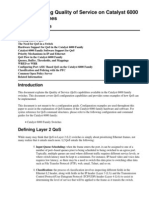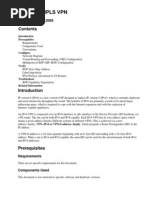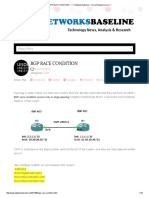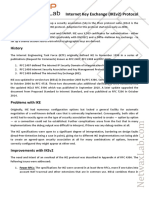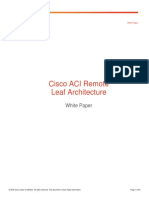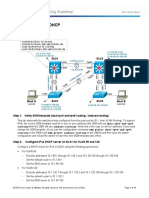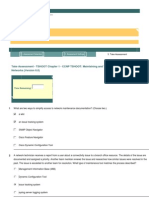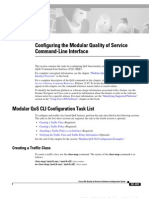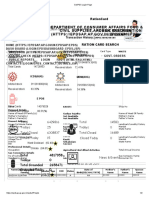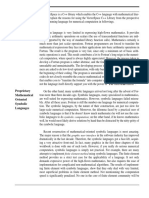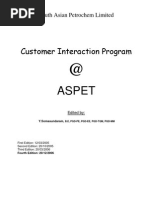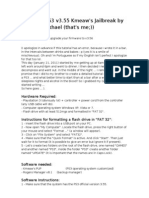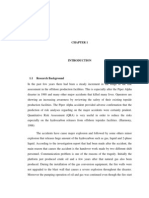Chapter 4-2 Lab - Multiple Spanning Tree: Topology
Chapter 4-2 Lab - Multiple Spanning Tree: Topology
Uploaded by
Jese DanielCopyright:
Available Formats
Chapter 4-2 Lab - Multiple Spanning Tree: Topology
Chapter 4-2 Lab - Multiple Spanning Tree: Topology
Uploaded by
Jese DanielOriginal Title
Copyright
Available Formats
Share this document
Did you find this document useful?
Is this content inappropriate?
Copyright:
Available Formats
Chapter 4-2 Lab - Multiple Spanning Tree: Topology
Chapter 4-2 Lab - Multiple Spanning Tree: Topology
Uploaded by
Jese DanielCopyright:
Available Formats
CCNPv7 SWITCH
Chapter 4-2 Lab Multiple Spanning Tree
Topology
Objectives
Implement Multiple Spanning Tree
Leverage VTP version 3 with MST
Background
Ciscos Per VLAN Spanning Tree (PVST) provides a significant step up from standard spanning tree in terms of
flexibility, allowing each VLAN to have its own independent spanning tree, thereby make better use of available
links in the network. A drawback to PVST is that there is an instance of PVST running for each VLAN in the
network, regardless of whether there are actually different spanning-tree topologies required. This presents the
potential for overwhelming the switch CPU and memory. Additionally, Cisco switches like those used in these labs
allow only a limited number of PVST instances usually 128. If more than 128 VLANs are created, some of them
will not have any STP running, and therefore not have any switching loop protection. PVST and Rapid PVST are
simply unusable in that kind of environment. Lastly, PVST and Rapid PVST are Cisco-proprietary protocols and
generally unusable in mixed vendor environments.
Cisco was involved in the early development of Multiple Spanning Tree. MST was standardized as IEEE 802.1s in
2002 and merged into 802.1Q in 2005. MST is an open protocol derived from RSTP, sharing all its rapid
convergence properties, and in fact, the only standardized spanning-tree protocol for VLAN-based networks
supported by multiple vendors. MST is a compromise between common spanning-tree and per-VLAN spanning
tree. An MST instance represents a unique spanning-tree topology. Multiple MST instances can be created to
account for each of the required spanning-tree topologies in a network, and an arbitrary number of VLANs can be
mapped to a single MST instance.
In this lab you will set up two instances of MST, one for VLANs 99 and 100 and the other for VLANs 110 and 120.
All other VLANs will be mapped to the default MST instance (also referred to as IST or Internal Spanning Tree).
2014 Cisco and/or its affiliates. All rights reserved. This document is Cisco Public.
Page 1 of 12
CCNPv7 SWITCH: Lab 4-2 Multiple Spanning Tree
Note: This lab uses Cisco Catalyst 3560 and 2960 switches running Cisco IOS 15.0(2)SE6 IP Services and LAN
Base images, respectively. The 3560 and 2960 switches are configured with the SDM templates dual-ipv4-andipv6 routing and lanbase-routing, respectively. Depending on the switch model and Cisco IOS Software version,
the commands available and output produced might vary from what is shown in this lab. Catalyst 3650 switches
(running any Cisco IOS XE release) and Catalyst 2960-Plus switches (running any comparable Cisco IOS image)
can be used in place of the Catalyst 3560 switches and the Catalyst 2960 switches.
Required Resources
2 Cisco 2960 with the Cisco IOS Release 15.0(2)SE6 C2960-LANBASEK9-M or comparable
2 Cisco 3560v2 with the Cisco IOS Release 15.0(2)SE6 C3560-IPSERVICESK9-M or comparable
Computer with terminal emulation software
Ethernet and console cables
Step 1: Prepare the switches for the lab
Use the reset.tcl script you created in Lab 1 Preparing the Switch to set your switches up for this lab. Then
load the file BASE.CFG into the running-config with the command copy flash:BASE.CFG running-config. An
example from DLS1:
DLS1# tclsh reset.tcl
Erasing the nvram filesystem will remove all configuration files! Continue? [confirm]
[OK]
Erase of nvram: complete
Reloading the switch in 1 minute, type reload cancel to halt
Proceed with reload? [confirm]
*Mar 7 18:41:40.403: %SYS-7-NV_BLOCK_INIT: Initialized the geometry of nvram
*Mar 7 18:41:41.141: %SYS-5-RELOAD: Reload requested by console. Reload Reason:
Reload command.
<switch reloads - output omitted>
Would you like to enter the initial configuration dialog? [yes/no]: n
Switch> en
*Mar 1 00:01:30.915: %LINK-5-CHANGED: Interface Vlan1, changed state to
administratively down
Switch# copy BASE.CFG running-config
Destination filename [running-config]?
184 bytes copied in 0.310 secs (594 bytes/sec)
DLS1#
Step 2: Configure Trunking
Next configure interfaces F0/7 through F0/12 as 802.1Q trunk ports on all four switches. Additionally,
configure all four switches VTP Servers. An example from DLS1:
DLS1# conf t
Enter configuration commands, one per line.
DLS1(config)# vtp mode server
End with CNTL/Z.
2014 Cisco and/or its affiliates. All rights reserved. This document is Cisco Public.
Page 2 of 12
CCNPv7 SWITCH: Lab 4-2 Multiple Spanning Tree
Setting device to VTP Server mode
DLS1(config)# int ran f0/7-12
DLS1(config-if-range)# switchport
DLS1(config-if-range)# switchport
DLS1(config-if-range)# switchport
DLS1(config-if-range)# switchport
DLS1(config-if-range)# switchport
DLS1(config-if-range)# no shut
DLS1(config-if-range)# exit
DLS1(config)#
for VLANS.
trunk encap dot1q
trunk native vlan 666
trunk allowed vlan except 1,999
mode trunk
nonegotiate
Step 3: Configure VTP and VLANs
To simplify the lab configuration, configure VTP version 2 on DLS1 with no password, and configure VLANs
for use in the network. This configuration will propagate to the other switches in the network.
DLS1# conf t
Enter configuration commands, one per line. End with CNTL/Z.
DLS1(config)# vtp domain SWLAB
Changing VTP domain name from NULL to SWLAB
DLS1(config)# vtp version 2
DLS1(config)# vlan 99
DLS1(config-vlan)# name MANAGEMENT
DLS1(config-vlan)# vlan 100
DLS1(config-vlan)# name SERVERS
DLS1(config-vlan)# vlan 110
DLS1(config-vlan)# name GUEST
DLS1(config-vlan)# vlan 120
DLS1(config-vlan)# name OFFICE
DLS1(config-vlan)# vlan 999
DLS1(config-vlan)# name PARKING_LOT
DLS1(config-vlan)# state suspend
DLS1(config-vlan)# vlan 666
DLS1(config-vlan)# name NATIVE_DO_NOT_USE
DLS1(config-vlan)# exit
*Mar 1 00:18:41.431: %SW_VLAN-6-VTP_DOMAIN_NAME_CHG: VTP domain name changed to
SWLAB.
DLS1(config)#
Verify that all of the VLANs propogate and that there is a single root bridge for all of the VLANs.
Step 4: Implement Multiple Spanning Tree
In this step you will implement MST on DLS1 and DLS2; we will ignore ALS1 and ALS2 for now.
Issue the global configuration command spanning-tree mode mst and then the privileged exec
command clear spanning-tree detected-protocols.
An example from DLS1:
DLS1#conf t
Enter configuration commands, one per line.
DLS1(config)# spanning-tree mode mst
End with CNTL/Z.
2014 Cisco and/or its affiliates. All rights reserved. This document is Cisco Public.
Page 3 of 12
CCNPv7 SWITCH: Lab 4-2 Multiple Spanning Tree
DLS1(config)#exit
DLS1# clear spanning-tree detected-protocols
DLS1#
DLS1# show spanning-tree
MST0
Spanning tree enabled protocol mstp
Root ID
Priority
32768
Step 5: Observe default MST configuration
At this point, MST is running with default parameters. On DLS1, issue the command show spanning-tree
mst configuration to see the configuration information:
DLS1# show span mst configuration
Name
[]
Revision 0
Instances configured 1
Instance Vlans mapped
-------- --------------------------------------------------------------------0
1-4094
------------------------------------------------------------------------------DLS1#
The output tells us
The region is un-named
The revision number is 0
There is one instance of MST, number 1, and VLANS 1-4094 are mapped to that instance
For MST to work, the region must be named and given a revision number (this revision number does not work
like VTP, it is just an administrator-assigned value). All the switches in the same region must have the same
region name and revision number, and have the same VLAN-to-instance mapping.
Step 6: Manually Configure MST
Now configure MST on both DLS1 and DLS2 with the following information (you must configure each switch
manually):
Region Name: CCNP
Revision Number: 1
VLAN Mappings: Instance 1: VLAN 99 and VLAN 100
MST region configuration is performed in a special mode under the global configuration that is entered using
the spanning-tree mst configuration command. You have to make the changes and exit from
configuration mode to have the changes applied; the changes are not applied until you exit. While in MST
configuration mode, you can use the show current and show pending commands to see how the
configuration stands. From DLS1:
2014 Cisco and/or its affiliates. All rights reserved. This document is Cisco Public.
Page 4 of 12
CCNPv7 SWITCH: Lab 4-2 Multiple Spanning Tree
DLS1# conf t
Enter configuration commands, one per line. End with CNTL/Z.
DLS1(config)# spanning-tree mst configuration
DLS1(config-mst)# name CCNP
DLS1(config-mst)# revision 1
DLS1(config-mst)# instance 1 vlan 99,100
DLS1(config-mst)#
DLS1(config-mst)# show current
Current MST configuration
Name
[]
Revision 0
Instances configured 1
Instance Vlans mapped
-------- --------------------------------------------------------------------0
1-4094
------------------------------------------------------------------------------DLS1(config-mst)#
DLS1(config-mst)# show pending
Pending MST configuration
Name
[CCNP]
Revision 1
Instances configured 2
Instance Vlans mapped
-------- --------------------------------------------------------------------0
1-98,101-4094
1
99-100
------------------------------------------------------------------------------DLS1(config-mst)#
DLS1(config-mst)#exit
DLS1(config)#end
DLS1#
DLS1# show span mst config
Name
[CCNP]
Revision 1
Instances configured 2
Instance Vlans mapped
-------- --------------------------------------------------------------------0
1-98,101-4094
1
99-100
------------------------------------------------------------------------------DLS1#
Wait a moment to let the topology settle and then issue the show spanning-tree mst command on
DLS1:
DLS1# show spanning-tree mst
2014 Cisco and/or its affiliates. All rights reserved. This document is Cisco Public.
Page 5 of 12
CCNPv7 SWITCH: Lab 4-2 Multiple Spanning Tree
##### MST0
Bridge
Root
vlans mapped:
1-98,101-4094
address e840.406f.7280 priority
32768 (32768 sysid
address e840.406f.6e00 priority
32768 (32768 sysid
port
Fa0/11
path cost
0
Regional Root address e840.406f.6e00 priority
32768 (32768 sysid
internal cost 200000
rem hops
Operational
hello time 2 , forward delay 15, max age 20, txholdcount
Configured
hello time 2 , forward delay 15, max age 20, max hops
Interface
---------------Fa0/7
Fa0/8
Fa0/9
Fa0/10
Fa0/11
Fa0/12
##### MST1
Bridge
Root
Role
---Desg
Desg
Desg
Desg
Root
Altn
Sts
--FWD
FWD
FWD
FWD
FWD
BLK
Cost
--------200000
200000
200000
200000
200000
200000
Prio.Nbr
-------128.9
128.10
128.11
128.12
128.13
128.14
vlans mapped:
99-100
address e840.406f.7280
address e840.406f.6e00
port
Fa0/11
Interface
---------------Fa0/7
Fa0/8
Fa0/9
Fa0/10
Fa0/11
Fa0/12
Role
---Desg
Desg
Desg
Desg
Root
Altn
Sts
--FWD
FWD
FWD
FWD
FWD
BLK
Cost
--------200000
200000
200000
200000
200000
200000
0)
19
6
20
Type
-------------------------------P2p Bound(PVST)
P2p Bound(PVST)
P2p Bound(PVST)
P2p Bound(PVST)
P2p
P2p
priority
priority
cost
Prio.Nbr
-------128.9
128.10
128.11
128.12
128.13
128.14
0)
0)
32769 (32768 sysid 1)
32769 (32768 sysid 1)
200000
rem hops 19
Type
-------------------------------P2p Bound(PVST)
P2p Bound(PVST)
P2p Bound(PVST)
P2p Bound(PVST)
P2p
P2p
As you can see from the output above, the VLANs are mapped to the correct instance and the root bridge for
both instances is not the local switch (it is DLS2 in this case).
Notice the type entry P2p Bound(PVST). This is the entry shown when the device connected at the other
end of the given interface is not running MST; in this case, ALS1 and ALS2 are running the default PVST.
Step 7: Propagate MST configurations with VTP
Manual configuration of MST is not particularly difficult until the network scales to a large size. For switches to
form a single MST region, they must match in all region parameters: region name, configuration revision,
VLAN-to-instance mappings. Switches that differ in their MST region configuration will form separate regions,
each region having its own internal root bridges for the defined MST instances and independent internal
topologies. While having multiple regions is not an error per se, and some large networks are even partitioned
into multiple regions intentionally, running multiple MST regions as a result of region misconfiguration is
undesirable.
VTP version 3 allows for the sharing of the MST database amongst switches, which simplifies this process
considerably.
2014 Cisco and/or its affiliates. All rights reserved. This document is Cisco Public.
Page 6 of 12
CCNPv7 SWITCH: Lab 4-2 Multiple Spanning Tree
To use VTP version 3 to propagate the MST region configuration to all switches in the VTP domain, convert
all switches to VTP version 3 and set them as servers or clients for MST. Then designate one switch as the
VTP primary for MST. Do not forget to activate MST on all switches; VTP version 3 will synchronize only the
region configuration across all switches and will not affect the STP version running on the switch.
From DLS2:
DLS2# conf t
Enter configuration commands, one per line. End with CNTL/Z.
DLS2(config)# vtp version 3
DLS2(config)#
*Mar 1 00:49:27.386: %SW_VLAN-6-OLD_CONFIG_FILE_READ: Old version 2 VLAN
configuration file detected and read OK. Version 3
files will be written in the future.
DLS2(config)#
DLS2(config)# vtp mode server mst
Setting device to VTP Server mode for MST.
DLS2(config)# end
DLS2# vtp primary mst
This system is becoming primary server for feature mst
No conflicting VTP3 devices found.
Do you want to continue? [confirm]
DLS2#
*Mar 1 00:55:45.217: %SW_VLAN-4-VTP_PRIMARY_SERVER_CHG: e840.406f.7380 has become the
primary server for the MST VTP feature
From ALS1 (the same configuration must be applied at ALS2):
ALS1# conf t
Enter configuration commands, one per line.
ALS1(config)# spanning-tree mode mst
ALS1(config)# vtp version 3
ALS1(config)# vtp mode server mst
Setting device to VTP Server mode for MST.
ALS1(config)# end
End with CNTL/Z.
Note: An identical MST region configuration will be propagated to all switches within a VTPv3 domain, and
consequently they will all form a single region. As a result, there is always a one-to-one mapping between a
VTPv3 domain and an MST region.
Step 8: Verify Initial MST Configuration
After the entire configuration is done, VTP version 3 will propagate the MST configuration to the other
switches. Verify this by checking ALS2:
ALS2# show spanning-tree mst configuration
Name
[CCNP]
Revision 1
Instances configured 2
Instance
Vlans mapped
2014 Cisco and/or its affiliates. All rights reserved. This document is Cisco Public.
Page 7 of 12
CCNPv7 SWITCH: Lab 4-2 Multiple Spanning Tree
-------- --------------------------------------------------------------------0
1-98,101-4094
1
99-100
------------------------------------------------------------------------------ALS2#show span mst
##### MST0
Bridge
Root
Operational
Configured
vlans mapped:
1-98,101-4094
address 0017.95cf.1680 priority
32768 (32768 sysid 0)
this switch for the CIST
hello time 2 , forward delay 15, max age 20, txholdcount 6
hello time 2 , forward delay 15, max age 20, max hops
20
Interface
---------------Fa0/7
Fa0/8
Fa0/9
Fa0/10
Fa0/11
Fa0/12
##### MST1
Bridge
Root
Role
---Desg
Desg
Desg
Desg
Desg
Desg
Sts
--FWD
FWD
FWD
FWD
FWD
FWD
Cost
--------200000
200000
200000
200000
200000
200000
Prio.Nbr
-------128.7
128.8
128.9
128.10
128.11
128.12
vlans mapped:
99-100
address 0017.95cf.1680
this switch for MST1
Interface
---------------Fa0/7
Fa0/8
Fa0/9
Fa0/10
Fa0/11
Fa0/12
Role
---Desg
Desg
Desg
Desg
Desg
Desg
Sts
--FWD
FWD
FWD
FWD
FWD
FWD
Cost
--------200000
200000
200000
200000
200000
200000
Type
-------------------------------P2p
P2p
P2p
P2p
P2p
P2p
priority
Prio.Nbr
-------128.7
128.8
128.9
128.10
128.11
128.12
32769 (32768 sysid 1)
Type
-------------------------------P2p
P2p
P2p
P2p
P2p
P2p
Step 9: Modify MST Configuration
To further illustrate the convenience of MST and VTP version 3, add another instance on DLS2, mapping
VLANs 110 and 120 to it.
DLS2# conf t
Enter configuration commands, one per line.
DLS2(config)# spanning-tree mst config
DLS2(config-mst)# instance 2 vlan 110,120
DLS2(config-mst)# show pending
Pending MST configuration
Name
[CCNP]
Revision 1
Instances configured 3
End with CNTL/Z.
2014 Cisco and/or its affiliates. All rights reserved. This document is Cisco Public.
Page 8 of 12
CCNPv7 SWITCH: Lab 4-2 Multiple Spanning Tree
Instance Vlans mapped
-------- --------------------------------------------------------------------0
1-98,101-109,111-119,121-4094
1
99-100
2
110,120
------------------------------------------------------------------------------DLS2(config-mst)#
DLS2(config-mst)# exit
DLS2(config)# end
DLS2#
And then verify on that the changes propagated to another switch:
DLS1# show span mst config
Name
[CCNP]
Revision 1
Instances configured 3
Instance Vlans mapped
-------- --------------------------------------------------------------------0
1-98,101-109,111-119,121-4094
1
99-100
2
110,120
------------------------------------------------------------------------------DLS1# show span mst
##### MST0
Bridge
Root
vlans mapped:
1-98,101-109,111-119,121-4094
address e840.406f.7280 priority
32768 (32768 sysid
address 0017.95cf.1680 priority
32768 (32768 sysid
port
Fa0/9
path cost
0
Regional Root address 0017.95cf.1680 priority
32768 (32768 sysid
internal cost 200000
rem hops
Operational
hello time 2 , forward delay 15, max age 20, txholdcount
Configured
hello time 2 , forward delay 15, max age 20, max hops
Interface
---------------Fa0/7
Fa0/8
Fa0/9
Fa0/10
Fa0/11
Fa0/12
##### MST1
Bridge
Root
Role
---Altn
Altn
Root
Altn
Altn
Altn
Sts
--BLK
BLK
FWD
BLK
BLK
BLK
Cost
--------200000
200000
200000
200000
200000
200000
Prio.Nbr
-------128.9
128.10
128.11
128.12
128.13
128.14
vlans mapped:
99-100
address e840.406f.7280
address 0017.95cf.1680
port
Fa0/9
0)
0)
0)
19
6
20
Type
-------------------------------P2p
P2p
P2p
P2p
P2p
P2p
priority
priority
cost
2014 Cisco and/or its affiliates. All rights reserved. This document is Cisco Public.
32769 (32768 sysid 1)
32769 (32768 sysid 1)
200000
rem hops 19
Page 9 of 12
CCNPv7 SWITCH: Lab 4-2 Multiple Spanning Tree
Interface
---------------Fa0/7
Fa0/8
Fa0/9
Fa0/10
Fa0/11
Fa0/12
##### MST2
Bridge
Root
Role
---Altn
Altn
Root
Altn
Altn
Altn
Sts
--BLK
BLK
FWD
BLK
BLK
BLK
Cost
--------200000
200000
200000
200000
200000
200000
Prio.Nbr
-------128.9
128.10
128.11
128.12
128.13
128.14
Type
-------------------------------P2p
P2p
P2p
P2p
P2p
P2p
vlans mapped:
110,120
address e840.406f.7280 priority
address 0017.95cf.1680 priority
port
Fa0/9
cost
Interface
---------------Fa0/7
Fa0/8
Fa0/9
Fa0/10
Fa0/11
Fa0/12
Role
---Altn
Altn
Root
Altn
Altn
Altn
Sts
--BLK
BLK
FWD
BLK
BLK
BLK
Cost
--------200000
200000
200000
200000
200000
200000
Prio.Nbr
-------128.9
128.10
128.11
128.12
128.13
128.14
32770 (32768 sysid 2)
32770 (32768 sysid 2)
200000
rem hops 19
Type
-------------------------------P2p
P2p
P2p
P2p
P2p
P2p
Step 10: Manipulate the spanning tree
To this point we have left election of the root bridge up to the protocol defaults, which are the same as PVST
with one exception port cost values, still based on the physical interfaces bandwidth, use much larger
numbers.
An example of the show spanning-tree root command at DLS1 provides proof that the root bridge is
elsewhere:
DLS1# show spanning-tree root
MST Instance
---------------MST0
MST1
MST2
DLS1#
Root
Hello Max Fwd
Root ID
Cost
Time Age Dly
-------------------- --------- ----- --- --32768 0017.95cf.1680
0
2
20 15
32769 0017.95cf.1680
200000
2
20 15
32770 0017.95cf.1680
200000
2
20 15
Root Port
-----------Fa0/9
Fa0/9
Fa0/9
Port costs, which are summed to find a path cost in the quest for a root bridge, are different in MST:
10 Mbps2,000,000
100 Mbps200,000
1 Gigabit Ethernet20,000
10 Gigabit Ethernet2,000
2014 Cisco and/or its affiliates. All rights reserved. This document is Cisco Public.
Page 10 of 12
CCNPv7 SWITCH: Lab 4-2 Multiple Spanning Tree
MST uses the same basic commands and values to manipulate its operation.
To manually configure a bridge to be the primary MST root, use the command spanning-tree mst
instance-list root {primary | secondary} global configuration command. You can also manually
set the bridge priority using the spanning-tree mst instance-list priority priority global
configuration command. In the example below, DLS1 is configured as the primary root for instance 0 and 1,
and the secondary root for instance 2:
DLS1# conf t
Enter configuration commands, one per line. End with CNTL/Z.
DLS1(config)# spanning-tree mst 0-1 root primary
DLS1(config)# spanning-tree mst 2 root secondary
DLS1(config)# end
DLS1#
DSL2 is configured with a complementary set of instructions; root primary for instance 2 and root secondary
for instances 0 and 1:
DLS2# conf t
Enter configuration commands, one per line. End with CNTL/Z.
DLS2(config)# spanning-tree mst 0-1 root secondary
DLS2(config)# spanning-tree mst 2 root primary
DLS2(config)# end
DLS2#
The results of these configuration changes are evident using the show spanning-tree root command.
From ALS1, which shows Fa0/7 (connected to DLS1) as the Root Port for instances 0 and 1 and Fa0/9
(connected to DLS2) for instance 2:
ALS1# show spanning-tree root
MST Instance
---------------MST0
MST1
MST2
ALS1#
Root ID
-------------------24576 e840.406f.7280
24577 e840.406f.7280
24578 e840.406f.6e00
Root
Hello Max Fwd
Cost
Time Age Dly
--------- ----- --- --0
2
20 15
200000
2
20 15
200000
2
20 15
Root Port
-----------Fa0/7
Fa0/7
Fa0/9
As with PVST, Root Port selection is based on total path cost to the root bridge. Path cost is the sum of Port
Costs. You can configure the port costs using the spanning-tree mst instance cost value interface
configuration command, which sets the cost for that instance alone.
As an implementation example, we will shutdown interfaces Fa0/9-10 on DLS2 and then change the port cost
value of ALS2s interface Fa0/7 to a lower number, causing the spanning tree for instance 2 to go through
ALS2.
2014 Cisco and/or its affiliates. All rights reserved. This document is Cisco Public.
Page 11 of 12
CCNPv7 SWITCH: Lab 4-2 Multiple Spanning Tree
On ALS2:
ALS2# config t
ALS2(config)# int f0/7
ALS2(config-if)# spanning-tree mst 2 cost 1000
ALS2(config-if)# exit
ALS2(config)# end
On DLS2:
DLS2# conf t
Enter configuration commands, one per line.
DLS2(config)# interface ran f0/9-10
DLS2(config-if-range)# shut
DLS2(config-if-range)# end
End with CNTL/Z.
And then finally examining ALS1:
ALS1# show spanning-tree root
MST Instance
---------------MST0
MST1
MST2
ALS1#
Root ID
-------------------24576 e840.406f.7280
24577 e840.406f.7280
24578 e840.406f.6e00
Root
Hello Max Fwd
Cost
Time Age Dly
--------- ----- --- --0
2
20 15
200000
2
20 15
201000
2
20 15
Root Port
-----------Fa0/7
Fa0/7
Fa0/11
Step 11: End of Lab
Use the tcl script reset.tcl created in Lab 1 to clear and reload all of your switches before the next lab.
2014 Cisco and/or its affiliates. All rights reserved. This document is Cisco Public.
Page 12 of 12
You might also like
- OSINT Free ToolsDocument4 pagesOSINT Free ToolsPero Peric100% (9)
- How To Create The Ultimate Mastermind GroupDocument53 pagesHow To Create The Ultimate Mastermind GroupChao Chaoo100% (1)
- Swift Vs Scala 2.11Document15 pagesSwift Vs Scala 2.11Alexander Borisov100% (3)
- Dillusion PeakShelfMorph Tutorial WEBDocument1 pageDillusion PeakShelfMorph Tutorial WEBpdf369No ratings yet
- Ccnpv7.1 Switch Lab4-2 MST InstructorDocument21 pagesCcnpv7.1 Switch Lab4-2 MST InstructorAustin GriffithNo ratings yet
- Ccnpv7.1 Switch Lab6-2 Hsrpv6 InstructorDocument23 pagesCcnpv7.1 Switch Lab6-2 Hsrpv6 InstructorAustin GriffithNo ratings yet
- Ccnpv7.1 Switch Lab8-1 Ip Sla Span StudentDocument13 pagesCcnpv7.1 Switch Lab8-1 Ip Sla Span StudentFrank GarzonNo ratings yet
- Chapter 7 Lab 7-1, Synchronizing Campus Network Devices Using Network Time Protocol (NTP)Document20 pagesChapter 7 Lab 7-1, Synchronizing Campus Network Devices Using Network Time Protocol (NTP)Erid RocaNo ratings yet
- Next-Generation switching OS configuration and management: Troubleshooting NX-OS in Enterprise EnvironmentsFrom EverandNext-Generation switching OS configuration and management: Troubleshooting NX-OS in Enterprise EnvironmentsNo ratings yet
- Layer 2 Switch SecurityDocument69 pagesLayer 2 Switch Securitydil17No ratings yet
- ACI Hardware Component - DCLessonsDocument7 pagesACI Hardware Component - DCLessonsravi kantNo ratings yet
- ACI Hardware Component - LEARN WORK ITDocument13 pagesACI Hardware Component - LEARN WORK ITravi kantNo ratings yet
- Cisco Viptela SDWAN TLOC ExtensionDocument25 pagesCisco Viptela SDWAN TLOC Extensionbuda.mabulayaNo ratings yet
- Understanding Quality of Service On Catalyst 6000 Family SwitchesDocument39 pagesUnderstanding Quality of Service On Catalyst 6000 Family SwitcheszhreniNo ratings yet
- 5 Label Distribution Protocol: 5.1 in This ChapterDocument132 pages5 Label Distribution Protocol: 5.1 in This Chapterravi kantNo ratings yet
- Ipv6 Over Mpls VPN 00Document7 pagesIpv6 Over Mpls VPN 00abc101014No ratings yet
- Yasser Auda CCIEv5 Unprotected GRE Tunnel, Protected GRE Tunnel With IPsec - VTIDocument7 pagesYasser Auda CCIEv5 Unprotected GRE Tunnel, Protected GRE Tunnel With IPsec - VTIMd. Rashedul AlamNo ratings yet
- CISCO ASA HairpinningDocument7 pagesCISCO ASA Hairpinningjsinghengineer1No ratings yet
- BGP RACE CONDITION - Networks Baseline - Cisco Engineers LiveDocument10 pagesBGP RACE CONDITION - Networks Baseline - Cisco Engineers LiveMatt CarterNo ratings yet
- 24 - Single-Area OSPFv2 ConfigurationDocument60 pages24 - Single-Area OSPFv2 ConfigurationJana MassadehNo ratings yet
- Interas Mpls VPNDocument34 pagesInteras Mpls VPNAmit Baran ChatterjeeNo ratings yet
- The BGP Null Route Trick - Ravi KDocument5 pagesThe BGP Null Route Trick - Ravi Kravi kantNo ratings yet
- SDWAN Command ListDocument9 pagesSDWAN Command Listtapesh nishadNo ratings yet
- Internet Key Exchange (IKEv2) ProtocolDocument10 pagesInternet Key Exchange (IKEv2) ProtocolPrashant TiwariNo ratings yet
- CCNP Route (642-902)Document12 pagesCCNP Route (642-902)Mashiur NayanNo ratings yet
- Cisco ACI Remote Leaf ArchitectureDocument43 pagesCisco ACI Remote Leaf Architectureravi kantNo ratings yet
- MPLS - Unicast IP ForwardingDocument9 pagesMPLS - Unicast IP ForwardingMohamed Oussema DerradjiNo ratings yet
- BGP Multihoming ExamplesDocument33 pagesBGP Multihoming ExamplesSFAYKAD ETNo ratings yet
- IGP Redistribution Part1Document82 pagesIGP Redistribution Part1Mauro NuñezNo ratings yet
- Configuring HSRP (Hot Standby Routing Protocol)Document3 pagesConfiguring HSRP (Hot Standby Routing Protocol)Sushil SharmaNo ratings yet
- Cisco ASA Dynamic NAT With DMZDocument3 pagesCisco ASA Dynamic NAT With DMZSon Tran Hong NamNo ratings yet
- BGPDocument61 pagesBGPzakia osmaniNo ratings yet
- 21.ACI Tenant, Bridge Domain & VRF - LEARN WORK ITDocument9 pages21.ACI Tenant, Bridge Domain & VRF - LEARN WORK ITravi kantNo ratings yet
- BRKDCT-2081 Cisco FabricPath Technology and Design (2011 London)Document98 pagesBRKDCT-2081 Cisco FabricPath Technology and Design (2011 London)vimalm15No ratings yet
- Cisco CCIE Lab Study GuideDocument7 pagesCisco CCIE Lab Study GuideMaulanaNo ratings yet
- Lab3 Cciesecv4 QuestionsetDocument32 pagesLab3 Cciesecv4 QuestionsetPhạm Quốc BảoNo ratings yet
- ROUTE 642-902 Training Policy Based Routing Sim PDFDocument24 pagesROUTE 642-902 Training Policy Based Routing Sim PDFmailbanwariNo ratings yet
- Ccnpv7.1 Switch Lab5-2 Dhcp46 StudentDocument16 pagesCcnpv7.1 Switch Lab5-2 Dhcp46 StudentCristianFelipeSolarteOrozcoNo ratings yet
- Ccna NotesDocument67 pagesCcna NotesIrshad KhanNo ratings yet
- EIGRP CCNP RouteDocument96 pagesEIGRP CCNP RouteRoberto TapiaNo ratings yet
- Enhanced Interior Gateway Routing ProtocolDocument25 pagesEnhanced Interior Gateway Routing ProtocolRobinson JoshuaNo ratings yet
- 2 Securing Network DevicesDocument1 page2 Securing Network DevicesQuang AnhNo ratings yet
- Configuring Ethernet Over Mpls (Eompls)Document10 pagesConfiguring Ethernet Over Mpls (Eompls)Le Viet HaNo ratings yet
- Ios Z - B F: ONE Ased IrewallDocument1 pageIos Z - B F: ONE Ased Irewallravi kantNo ratings yet
- Intro To OTVDocument29 pagesIntro To OTVSon Tran Hong NamNo ratings yet
- 11.3.4.6 Lab - Using The CLI To Gather Network Device InformationDocument8 pages11.3.4.6 Lab - Using The CLI To Gather Network Device InformationSachinNo ratings yet
- How To Configure BGP Local Preference AttributeDocument4 pagesHow To Configure BGP Local Preference AttributeSon Tran Hong NamNo ratings yet
- Cisco IP Security Troubleshooting Understanding and Using Debug CommandsDocument14 pagesCisco IP Security Troubleshooting Understanding and Using Debug CommandsRaj KaranNo ratings yet
- Ccip Mpls NotesDocument32 pagesCcip Mpls NotesretovaNo ratings yet
- WLC Tshoot CommandsDocument4 pagesWLC Tshoot Commandstapesh nishadNo ratings yet
- Policy-Based Routing On Fortigate Firewall - Plain Tutorials PDFDocument5 pagesPolicy-Based Routing On Fortigate Firewall - Plain Tutorials PDFkflimNo ratings yet
- DAI (Dynamic ARP Inspection)Document11 pagesDAI (Dynamic ARP Inspection)mandijnns1100% (1)
- PaloAlto Basic Migration From Check Point To Palo Alto NetworkDocument20 pagesPaloAlto Basic Migration From Check Point To Palo Alto NetworkiWeeeNo ratings yet
- CISCO ASA - DNS DoctoringDocument6 pagesCISCO ASA - DNS Doctoringjsinghengineer1No ratings yet
- Tshoot Chapter1 SolutionDocument7 pagesTshoot Chapter1 Solutionawersdf40% (5)
- Cisco IOS IP SLAs Configuration GuideDocument332 pagesCisco IOS IP SLAs Configuration GuideenragonNo ratings yet
- 4 Filter Policies: 4.1 ACL Filter Policy OverviewDocument48 pages4 Filter Policies: 4.1 ACL Filter Policy Overviewravi kantNo ratings yet
- Cisco 3750 Configuration GuideDocument1,010 pagesCisco 3750 Configuration GuideRolando IbañezNo ratings yet
- QoS CLIDocument12 pagesQoS CLIRamnot AkNo ratings yet
- ACI Multi-Pod Upgrade MOP - Adecco v.05Document71 pagesACI Multi-Pod Upgrade MOP - Adecco v.05ravi kantNo ratings yet
- CCNP Switching LAB Preparation TestDocument2 pagesCCNP Switching LAB Preparation TestGiannisDemetriouNo ratings yet
- l3 HSRPDocument32 pagesl3 HSRPmouhannadn.alrightNo ratings yet
- In Depth Guide to IS-IS Routing: Learn Intermediate System to Intermediate System Routing from scratchFrom EverandIn Depth Guide to IS-IS Routing: Learn Intermediate System to Intermediate System Routing from scratchNo ratings yet
- Sales and Distribution-Mm: Made By-Bhaibhab Nath Deepshikha Bansal Jignesh Joshi Mehak Oberoi Rashi Jain Sonal SmritiDocument22 pagesSales and Distribution-Mm: Made By-Bhaibhab Nath Deepshikha Bansal Jignesh Joshi Mehak Oberoi Rashi Jain Sonal Smritiapi-3757629No ratings yet
- Practical: 2: Install and Test Network Interface CardsDocument6 pagesPractical: 2: Install and Test Network Interface CardsManoj BiswasNo ratings yet
- Discovering Opensees: Surfing The Waves of Opensees: Adding Your Code To OpenseesDocument47 pagesDiscovering Opensees: Surfing The Waves of Opensees: Adding Your Code To Openseeshal9000_mark1No ratings yet
- Tablas Firebird v.2.5 RDB RELATIONSDocument3 pagesTablas Firebird v.2.5 RDB RELATIONSagus_pnaenseNo ratings yet
- Computer ApplicationDocument12 pagesComputer ApplicationTrixy RegeroNo ratings yet
- Study of Information Systems at Fortis, Noida: MIS Project (112502)Document21 pagesStudy of Information Systems at Fortis, Noida: MIS Project (112502)Deepali NandaNo ratings yet
- Department of Consumer Affairs Food & Civil Supplies, Andhra Pradesh (Https://Epdsap - Ap.Gov - In/Epdsap/Epds) Public Distribution SystemDocument2 pagesDepartment of Consumer Affairs Food & Civil Supplies, Andhra Pradesh (Https://Epdsap - Ap.Gov - In/Epdsap/Epds) Public Distribution SystemsrikarbNo ratings yet
- Vector SpaceDocument647 pagesVector SpaceDfl7No ratings yet
- IDC MarketScape IT Project and Portfolio Management 2009Document54 pagesIDC MarketScape IT Project and Portfolio Management 2009Quarry CeroNo ratings yet
- User Manual 5226190Document19 pagesUser Manual 5226190richyfeynman1918No ratings yet
- Machine Arrangement: 269-2044 CHASSIS ARDocument3 pagesMachine Arrangement: 269-2044 CHASSIS ARSidney RodriguesNo ratings yet
- Leads - Hema1Document12 pagesLeads - Hema1Hema AnanthkumarNo ratings yet
- PET Processing V4 - 1Document48 pagesPET Processing V4 - 1Somasundaram Yamaraja100% (5)
- Microwave Engineering Unit 5 Jntuh (Hand Written Notes)Document26 pagesMicrowave Engineering Unit 5 Jntuh (Hand Written Notes)RAJKUMAR SAMIKKANNUNo ratings yet
- Typesofcomputersystemerror 160120080549Document46 pagesTypesofcomputersystemerror 160120080549Kriz Anthony Zuniega100% (1)
- System-On-Chip Design Book 2019 200dpi AwDocument334 pagesSystem-On-Chip Design Book 2019 200dpi AwAndrea SpitaleNo ratings yet
- C M S College of Engineering, Namakkal - 637 003 Department of Management Studies BA9210 Strategic Management Unit - IDocument10 pagesC M S College of Engineering, Namakkal - 637 003 Department of Management Studies BA9210 Strategic Management Unit - IAnonymous 8SNpyXNo ratings yet
- Inspection Report - 52NH1778Document8 pagesInspection Report - 52NH1778Tanush KumarNo ratings yet
- TCHITOLADocument7 pagesTCHITOLAhilario2bastosluembaNo ratings yet
- DHCP Option 60 Tb54041Document4 pagesDHCP Option 60 Tb54041khojsNo ratings yet
- 14-007 WD2250B - 2014.2.18Document8 pages14-007 WD2250B - 2014.2.18Cuc CucNo ratings yet
- Wrfue Description: Huawei Technologies Co., LTDDocument14 pagesWrfue Description: Huawei Technologies Co., LTDEng Sherif MahmoudNo ratings yet
- Role of Packaging Material On Pharmaceutical Product StabilityDocument3 pagesRole of Packaging Material On Pharmaceutical Product StabilitySneha PatelNo ratings yet
- Tutorial PS3 Kmeaw's Jailbreak by ArcangelMikhael ENGDocument10 pagesTutorial PS3 Kmeaw's Jailbreak by ArcangelMikhael ENGBear RimandoNo ratings yet
- Gripper Design GuidelinesDocument11 pagesGripper Design Guidelinesengr_faheemNo ratings yet
- Chapter 1Document8 pagesChapter 1LINA AK BALUNNo ratings yet














